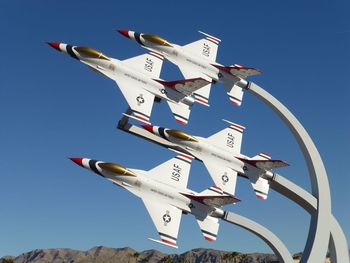Nellis Air Force Base
|
Nellis Air Force Base (1941-Active) - A United States Air Force base first established in 1941 as Las Vegas Army Airfield at North Las Vegas, Clark County, Nevada. Renamed Las Vegas Air Force Base in 1949, renamed again Nellis Air Force Base after Lieutenant William Harrell Nellis in 1950. Lt Nellis was a P-47 pilot from southern Nevada who was killed in action on 27 Dec 1944, over Luxembourg during the Battle of the Bulge in World War II. Active military installation.
Mission(The following text is adapted from USAF Nellis AFB Fact Sheet dated 28 Oct 2014) Nellis Air Force Base, a part of the United States Air Force's Air Combat Command, is located approximately eight miles northeast of Las Vegas, Nev. The base covers more than 14,000 acres, while the total land area occupied by Nellis and its restricted ranges is about 5,000 square miles. An additional 7,700 miles of airspace north and east of the restricted ranges are also available for military flight operations. Nellis is a major focal point for advanced combat aviation training. Its mission is accomplished through an array of aircraft, including fighters, bombers, refuelers, and aircraft used for transport, close-air-support, command-and-control, and combat search-and-rescue. The Nellis workforce of about 9,500 military and civilians makes it one of the largest single employers in Southern Nevada. The total military population numbers more than 40,000, including family members and military retirees in the area. World War IINellis began as the Las Vegas Army Airfield in late 1941, hosting the Army Air Corps Flexible Gunnery School which started B-17 gunnery training in early 1942. In 1944, B-17 co-pilot training was added. During the height of World War II, more than 600 gunners and 215 co-pilots graduated from the school every five weeks. In March 1945, B-17 co-pilot training was canceled and the gunnery program gave way to B-29 gunnery training. Following the war's end, the base was a separation center and then placed on temporary standby status, finally closing in January 1947. Post World War IIReopened in 1949 as Las Vegas Air Force Base, it was renamed on 30 Apr 1950 in honor of Lieutenant William Harrell Nellis. Lt. Nellis, a P-47 pilot from southern Nevada, was killed in action on 27 Dec 1944, while on his 70th combat mission over Luxembourg during the Battle of the Bulge in support of the besieged 101st Airborne Division. Initially an advanced pilot training base, the mission changed to F-86 flight training and gunnery for qualified pilots. During the Korean War, the training received at Nellis AFB was directly responsible for the 14-1 kill ratio of the F-86 against the superior MiG-15. At the time, Nellis was the only base training F-86 combat pilots - pilots returning from the theater were used as instructors at the Combat Crew Training School and provided the air expertise that allowed the United States to maintain air superiority throughout the war. The Air Force Demonstration Team, the Thunderbirds, moved to Nellis AFB in 1956. The team provides demonstrations of precision flying in front-line combat aircraft. The demonstration team has performed for millions of people stateside and overseas allowing the public to see the dedication, skill, and training of USAF officers and airmen. With a 1958 transfer from Air Training Command to Tactical Air Command, the mission transitioned from initial aircraft qualification and gunnery training to advanced, graduate-level weapons training. The USAF Tactical Fighter Weapons Center (now Warfare Center) was activated in 1966. In 1975, Red Flag air-to-air exercises were started and in 1990, the Air Warrior, now Green Flag-West, air-to-ground training mission moved to Nellis AFB.
Current StatusActive Air Force Base, as part of the USAF Warfare Center (USAFWC), units at Nellis continue to provide training for composite strike forces that include every type of aircraft in the U.S. Air Force inventory, along with air and ground units of the Army, Navy, Marines and air units from allied nations. Nellis is also responsible for the operational test, evaluation, and tactics development.
See Also: Sources: Links:
Fortification ID:
Visited: 24 Feb 2014
| |||||||||||||||||||





